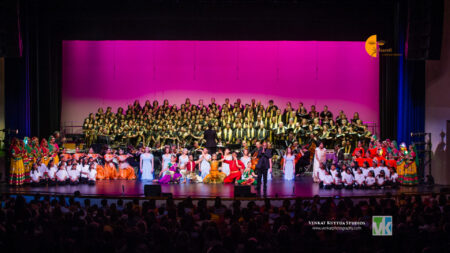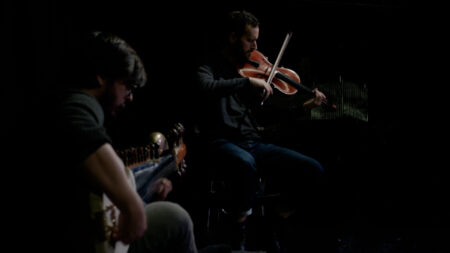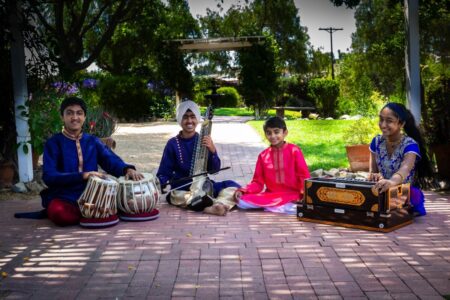Through their music, Roopa Mahadevan and Aditya Prakash have connected with all races, genders, orientations and age groups.
To dare to be different in presenting an art form permeated by tradition, lineage and seemingly inviolable rules requires courage, and especially so when you are the headliner of your own eponymous crossover band. Roopa Mahadevan of Roopa in Flux and Aditya Prakash of Aditya Prakash Ensemble have bridged the worlds of Carnatic classical music and contemporary world music in absorbing ways.
Solid Carnatic vocalists with years of training from critically acclaimed Gurus, Roopa and Aditya have been melding the genre with world sounds, creating a repertoire inextricably entrenched in Carnatic roots, yet unshackled and flexible in form. Born to South Indian parents in California, both were raised with a healthy respect for Indian dance and music. Roopa, whose mother had learned Bharatanatyam and her father, mridangam, was raised near San Francisco. Aditya grew up in the Los Angeles area around anklet bells and Carnatic music, his mother, Viji Prakash, being a long-standing local Bharatanatyam Guru.
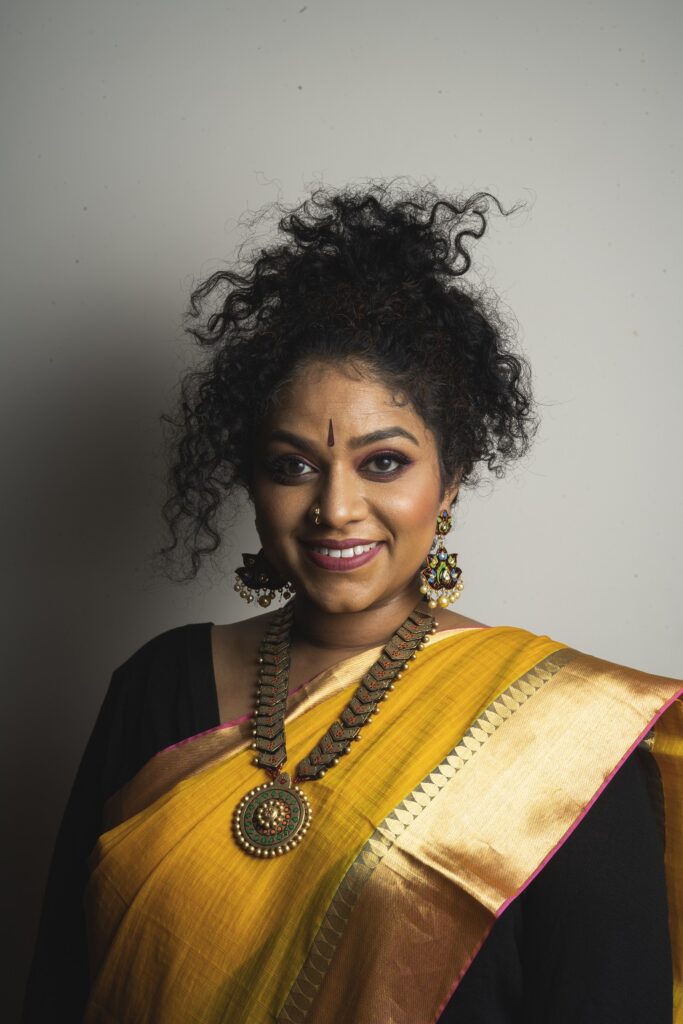
Roopa learned Carnatic vocal from Asha Ramesh and Bharatanatyam from Indumathy Ganesh. She also participated in her high school choir and musical theatre (Guys and Dolls) where she did singing and acting roles. She listened to “big voices with a lot of feel” like Whitney Houston, Mariah Carey and many more. The African American soul tradition touched her. “It felt full of purpose – almost as though they could not help but sing.” Roopa too is unfettered in performance, her vivacious personality and infectious enthusiasm shining through. “I have been told I do ‘abinayam’ while singing,” she says with a smile. “Women in Carnatic music are always told ‘adakka odukkam aa iru’ (translating to ‘be modest and careful about your movements’). But it is actually very difficult to rein oneself in physically whilst being fully absorbed in creative singing, probably why the leading male musicians are vigorously moving.”
Melding Melodies
Aditya learned vocal from Debur Srivatsa and mridangam from Ananthakrishnan and Neyveli Narayanan. For several years, he did not reveal his interest in Carnatic music outside of the Indian community. It was the only music he identified with though, narrating how he was utterly unfamiliar what his schoolmates listened to but knew every phrase of Semmangudi Srinivasa Iyer’s 1964 Music Academy’s concert. From age 11, he spent every summer in Chennai, learning music from esteemed teachers. His friends assumed he was visiting family. “But I have no family in Chennai,” says Aditya whose parents hail from Karnataka. Touring with the renowned sitariya Ravi Shankar at age 16 made him more comfortable and confident in his identity as a musician. “My school friends were surprised when they learned I had performed at Carnegie Hall, The Hollywood Bowl etc.” This was a true shot in the arm, giving him the confidence to reveal his musical side. With no Western music training, he tried out for the role of the Beast in his high school production of Beauty and the Beast and got it – the very first time he sang in English.
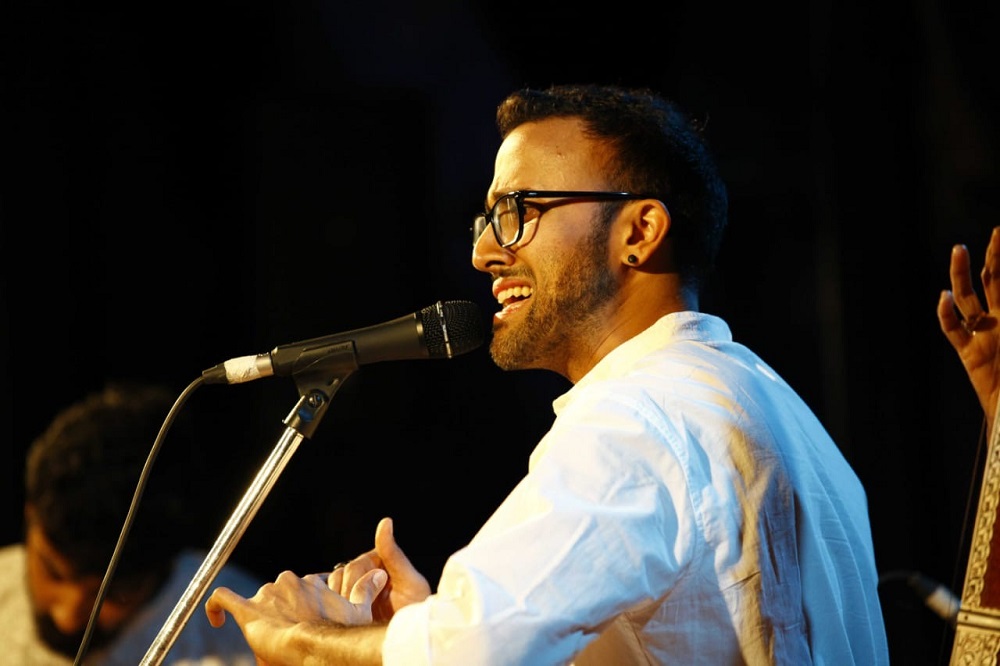
Roopa went to Stanford where she studied Biology and then completed a Masters in Psychology. All the while, she continued practicing Carnatic music. A program from Stanford’s Institute for Diversity in the Arts exposed her to artistes who used their art to highlight social issues or improve marginalised communities. It widened her artistic bounds, giving her confidence to express world issues of all kinds through the lens of art. After graduation she went to Chennai on a Fulbright scholarship to pursue advanced Carnatic training from the scion of the reputed Musiri school, Suguna Varadachari.
When Aditya got accepted at UCLA for college, he consulted Ravi Shankar, conflicted on whether to pursue music as a career or a hobby. The doyen said he had the talent and the drive and he ought to just plunge into music. Aditya did go to UCLA and graduated with a degree in Ethnomusicology. This pivotal chapter exposed him to several other types of musics and practitioners, each of whom had come from rigour in their respective fields. “It expanded my understanding of cultures and musics and also helped me envision a space where Indian music correlates and dialogues with other traditions, and especially with my American context.”
At the end of the Fulbright Fellowship, Roopa debated staying on in India to pursue a Carnatic career. It was 2007, when the historic Democratic Presidential nomination between Barack Obama and Hillary Clinton was taking place. Wanting to be in the USA at this unprecedented time, she returned, soon moving to New York with its thriving music culture and employment prospects. Straddling music alongside employment, she began by singing for local dancers’ performances, casual gigs at graduations parties etc. For the first time, she met full time musicians of all genres. “Being their sole identity, these artistes needed their music to convey much more.” She also met several non-south Asians keenly interested in Indian music. It was their enthusiasm that showed her the possibilities for crossover music. “After thinking of Ravi Shankar and John McLaughlin as their lineage, they were excited to have formally trained Indian musicians in their midst.”
His UCLA experience made it clear to Aditya that he did not now want to be solely a Carnatic musician. He wanted to compose, create his own pieces, make a repertoire. To this end, he created the Aditya Prakash Ensemble, a band of musicians of multiple genres, each trying to stay true to its very different origins, sans dilution, yet coming together to present concordant pieces of music. Finally, he could see all the contemporary music he had heard around him in conversation with the Carnatic that he felt at home with. Aditya describes the ensemble as “a collaboration that breaks down walls between the cultures of jazz and Indian classical music, to discover music that is free from genre. Through the common language of improvisation, as well as compositions that uniquely blend Indian ragas and complex rhythms, with Jazz’s rich harmonic structure, the group seeks to illuminate the transcendental nature of music.”
Starting bands
Roopa became an integral part of Brooklyn Raga Massive (BRM), a group that presented world musicians interested in raga-based music. Besides being featured in its Carnatic Sundays program, where skilled Carnatic musicians presented traditional concerts but at a jazz club, she had opportunities to perform with world musicians of different styles. At the request of the Navatman group, she also began group lessons for a few interested individuals of varying ability levels. “Many had negative experiences from previous training, like shame, disappointment, failure etc. – from pressure of meeting parents’, teachers’ and others’ expectations. I tried to get them to shed all that and just revel in the pleasure of singing just for the fun of it.” This led to the Navatman Music Collective, Roopa’s brainchild, a Carnatic-based choir. The Choir released many videos and did several programs critically acclaimed in the local media.
Eight years later, Roopa decided on music full-time. She soon released an album, Roopa in Six Yards, and started her own crossover band Roopa in Flux. Collaborating with musicians of many genres, she explores multiple layers of sound around the oeuvre of Carnatic music. “In a way, Carnatic allows for variety and quirkiness in expression. The depth of the ragam and technicalities take centre stage and are more critical than the voice. Carnatic is so porous – the art has adapted with the work of artistes who are continually pushing boundaries.”
Both have reached broad audiences. Referring to performing at alternate venues like pubs and jazz clubs, Roopa says, “For second-generation desis like me, it is very meaningful to listen to a Ragam Tanam Pallavi while drinking a glass of wine and eating a plate of pasta,” That Roopa and Aditya have connected with audiences of all races, genders, orientations and age groups, those familiar with and utterly new to the sounds, is a testament to their work.
As full-time musicians in a very competitive field, effective marketing is essential. Tooting one’s own horn, however, does not come easily to traditionally trained Carnatic musicians, who are taught to be self-effacing. “Students from schools like Juilliard and Berklee are actually taught to market themselves,” says Roopa. “Right from learning how to work with a western instrumentalist and adapt to a western scale, I had to learn that myself.” This might have been easier for Aditya given his degree in ethnomusicology, but he encounters challenges of his own. He candidly says, “I find it very difficult to sing in English. It does not sound tonally natural to me.”
He constantly ponders on and reimagines what Carnatic means to him. His more recent training with R.K. Shriramkumar and T.M. Krishna has helped further fructify his thought processes. Collaborations with Ravi Shankar, Anoushka Shankar, Tigran Hamasyan and Akram Khan exposed Aditya to “the power and connectivity of blending the ancient spiritual qualities of a tradition with a contemporary modern aesthetic.” Breaking the spectre of antiquity and being unrestricted from format opens up a different space in the mind.
One is left in no doubt as to Aditya’s and Roopa’s dedication and infectious love for the Carnatic form. To perform it in a carefully thought-out contemporary manner that is more reflective of the country, contexts and people they are accustomed to, and to do it full-time, has required conviction. “If it feels true and honest to us, it will reach the audience,” says Roopa. Aditya identifies with T.M. Krishna’s statement that if one removes all external trappings, Carnatic music is, at its heart, just raga, tala and sahitya. “We are doing a disservice to the art by boxing it in,” he concludes.


